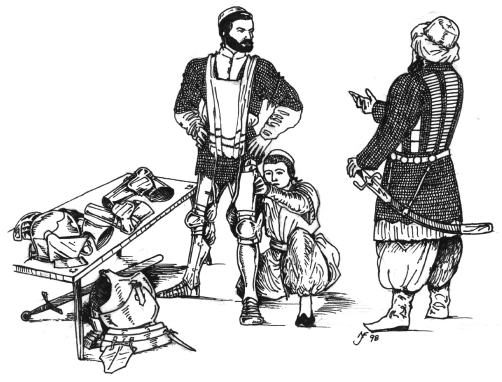By Norman J. Finkelshteyn
Ancient, Classical,
and Modern Eras
Yemen (Himayar)
Beyond The Sambation -
The Jews of Ethiopia
(the Bata Yisrael or Falashas)
The Middle East -
Muslim Conquests through The Crusades
Spain before the Expulsion
The Khazar Kaganate
Persia and Central Asia
Refugees from Spain and Portugal
Caveats in Researching Jewish History
Hairstyle of the Jewish Khazar
Israel Today --
Notes on the Current Conflict
Copyright and Authoring information
Norman Finkelshteyn's
Armour History Site
http://www.geocities.com/normlaw
Visit
Silk Road Designs Armoury
http://www.enteract.com/~silkroad
 Sephardic Refugees in Turkey See brief discussion below. |
However, now that they were considered Christian, the Catholic courts had authority over them and their "Judaising" became a Heresy punishable by the Inquisition. Great numbers of these Conversos perished in the fires of the Inquisition throughout the sixteenth century. Others eventually escaped, following their fellow Jews and rejoining Jewish communities. Yet others succeeded in their ruse so well that their descendants failed to realize the meaning of their family's secret rituals. Such secret Converso families, and even communities are being discovered today in Spain, South America, and Hawaii and the descendants of these Conversos are coming to understand their origins, often returning fully to Judaism.
The first refuge of these Spanish Jews was nearby Portugal but a few years later Portugal followed suit with it's own edicts. But in Portugal, rather than the slow death toll of the Inquisition, the "New Christians" were decimated in a week's orgy of violence called "The Massacre of New Christians in Lisbon" (the murderous mob also killing any Portuguese who happened to "Look Jewish").
Turkey
Among the chiefly Jewish professions in Spain and Portugal were metalworking in general and armouring in particular. Retaining the religious openness of their nomad past, Muslim Turkey saw the value of these artisans to its development as a world power. The Jewish refugees were therefore welcomed into Ottoman Turkey.
In addition to their skill as artisans, the Jews soon proved themselves as warriors and military strategists so that, by the end of the sixteenth century, Jewish soldiers attained the highest positions in the Turkish military. One of these soldiers, a Jewish general, proved himself so valuable to the Turkish state that, in reward for his service he was granted control of the area surrounding Tiberius, in Israel. Joseph ha Nasi, as he was called, used that opportunity to encourage the redevelopment of the Jewish community in Northern Israel.
Brazil
Other Spanish and Portuguese refugees, taking advantage of the millenialist religious tolerance of the Protestant Dutch, established a community in Holland and the Dutch colony of Brazil. In the war that was waged when Portugal took Brazil, the fierce bravery of the Jewish refugees was noted with gratitude by the Dutch government. It was in recognition of that bravery that the government in Holland forced Peter Stuyvesant, the anti-Semitic governor of New Amsterdam, to allow the first Jewish immigrants into his city.
Pictured above is a group of Jews at such a backyard Tournament. The man nearest the table is preparing to participate in the contest. He is wearing an arming doublet (padded coat) with maile skirt and gussets (reinforcements for arm and underarm). Over this is his Small Talit, a version of the four cornered, fringed cloak modified to be worn under clothing, which is worn to this day by many Jews. The armour on the table, with the leg armour he is already wearing is a late 15th century armour of Italian style (all western armour generally being of either Italian or German style). Under the table, balanced on the breast plate, is a rebated sword (a sword without edge or point) for use in the tournament. A knight was normally helped in putting on armour by a squire -- a boy who was training from that knight to become a knight himself. In the case of this Spanish refugee, the squire was most likely to be a son or nephew. The boy is dressed in Turkish style, in Kaftan, baggy trousers, and slippers. The Jews very quickly became part of the Turkish military and won themselves positions of high renown. The second man's "Korazin" armour (Turkish coat of maile and plates) and light, cloth covered cylindrical helmet, mark him as an officer. However, he wears no arm or leg defenses, which he would wear if he was on duty. About European style Armour About Maile and Plates About Maile |
| Main Page |
|---|